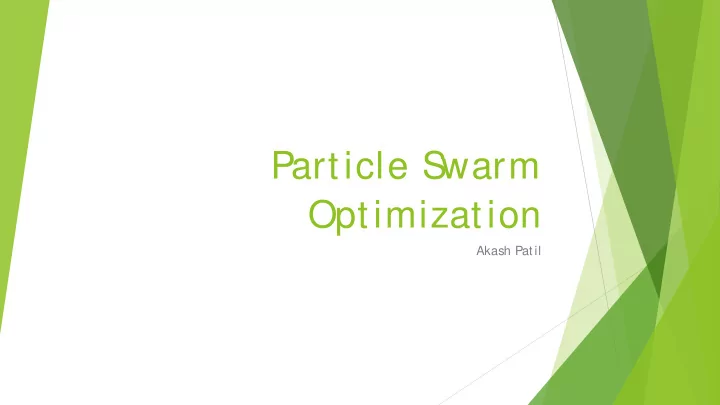

Particle S warm Optimization Akash Patil
Problem Definition A simple example - given function Find the maximum and position of maximum for 25 - (x - 05)^2 Fitting a polynomial through a given data Data for (x,y) given for some number of points Find the coefficients a,b,c,… for polynomial of type a + b*x^2 + c*x^3 …
Basics of Particle S warm Optimization Generate initial population randomly Each particle is searching for its optimum Each particle remembers its own personal best Each particle is moving and so has a velocity associated with it Velocity is has 2 main components – Towards its pbest Towards the gbest in the swarm v = v + c1*rand()*(pbest_position – current_position) + c2*rand()*(gbest_position – current_position)
Maximum of a given function Function chosen y = 25 - (x - 5)^2 10 particles 200 iterations Converges to (5,25) Convergence depends on values of C1 and C2 Too low, particles can’ t move much, too high, particles move too fast
Fitting a polynomial through given data Generated 2 arrays – x and y, with y = f(x) + rand() In this case, a particle would be a tuple of (a,b,c..) Can be considered to be a PS O in multiple dimensions The matlab function returns an array of coefficients of the fitted polynomial Given function -> 6 – x +5*x^2 output function -> -4.4168 + 3.427*x + 4.6557*x^2 Given function -> x*(10 - x) output function -> 1.1814+ 9.451*x + -0.9422*x^2 Given function -> (x-1)*(x-4)*(x-8) output function -> -3.7254 + 2.1919*x + -2.7297*x^2 + 0.2972*x^3
Plots 6 – x +5*x^2 Fitted data vs original data Original data, fitted data 600 600 500 500 400 400 300 300 Original dat a Fit ted dat a 200 200 100 100 0 0 0 2 4 6 8 10 12 0 100 200 300 400 500 600 -100 -100
Plots x*(10 - x) Fitted data vs original data Original data, fitted data 30 30 25 25 20 20 Original dat a 15 15 Fit ted dat a 10 10 5 5 0 0 0 2 4 6 8 10 12 0 5 10 15 20 25 30
Plots (x-1)*(x-4)*(x-8) Fitted data vs original data Original data, fitted data 120 50 100 40 80 30 60 20 Original dat a 40 10 Fit ted dat a 20 0 -40 -20 0 20 40 60 80 100 120 0 -10 0 2 4 6 8 10 12 -20 -20 -40 -30
Conclusion Particle swarm optimization code, in this case, works good in finding the optimal solution of the given problems if the degree of polynomial is given as 2 i.e. quadratic When the degree is increased to 4, the code isn’ t able to provide a good solution The different parameters that can be varied to control the performance of the algorithm are – Number of particles (generally 10-50) more particles, more region covered number of iterations C1 – importance of personal best C2 – importance of global best
Recommend
More recommend